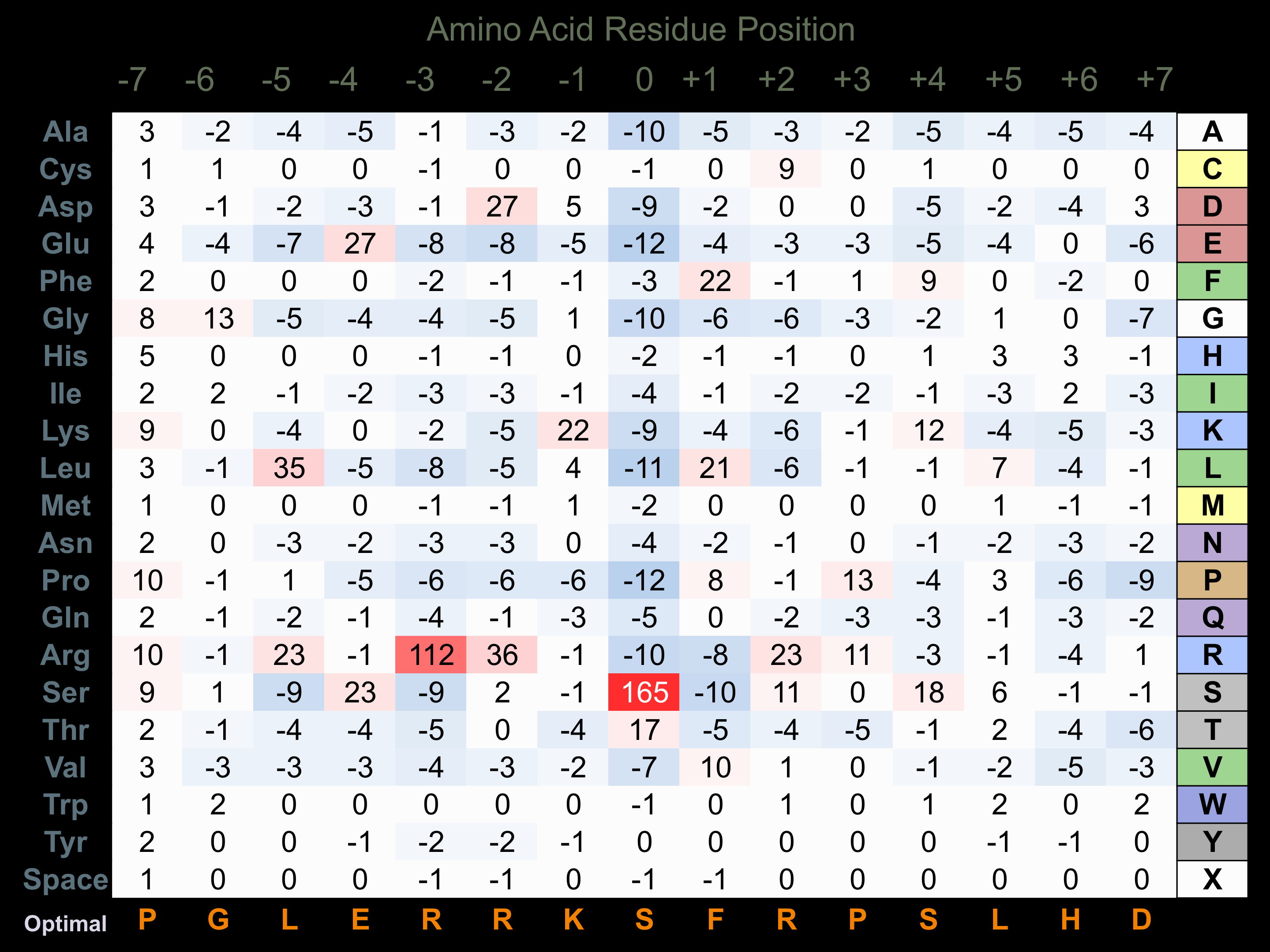Nomenclature
Short Name:
DCAMKL1
Full Name:
Serine-threonine-protein kinase DCAMKL1
Alias:
- DCAK1
- DCDC3A
- EC 2.7.11.1
- KIAA0369
- Kinase DCAMKL1
- DCLK
- DCLK1
- Doublecortin- like and CAM kinase-like 1
- Doublecortin-like kinase 1
Classification
Type:
Protein-serine/threonine kinase
Group:
CAMK
Family:
DCAMKL
SubFamily:
NA
Structure
Mol. Mass (Da):
82,224
# Amino Acids:
740
# mRNA Isoforms:
4
mRNA Isoforms:
82,224 Da (740 AA; O15075); 81,100 Da (729 AA; O15075-2); 47,681 Da (433 AA; O15075-4); 46,557 Da (422 AA; O15075-3)
4D Structure:
NA
1D Structure:
3D Image (rendered using PV Viewer):
PDB ID
Subfamily Alignment

Domain Distribution:
Kinexus Products
Click on entries below for direct links to relevant products from Kinexus for this protein kinase.
hiddentext
Post-translation Modifications
For detailed information on phosphorylation of this kinase go to PhosphoNET
Methylated:
R712 (M2).
Serine phosphorylated:
S32, S164, S172, S274, S305, S307, S312, S313, S327, S330, S332, S334, S337, S340, S352, S353, S489, S683, S729, S738.
Threonine phosphorylated:
T34, T46, T324, T336, T678, T687, T732.
Tyrosine phosphorylated:
Y265, Y493, Y725.
Distribution
Based on gene microarray analysis from the NCBI
Human Tissue Distribution
% Max Expression:
Mean Expression:
Number of Samples:
Standard Deviation:
% Max Expression:
Mean Expression:
Number of Samples:
Standard Deviation:
 77
77
1226
44
1365
 14
14
229
19
637
 5
5
81
14
69
 61
61
967
164
1039
 53
53
843
44
653
 45
45
710
100
2458
 10
10
158
55
351
 25
25
403
52
620
 17
17
276
17
222
 5
5
73
137
207
 2
2
33
40
75
 29
29
470
215
532
 6
6
89
38
94
 12
12
193
16
563
 5
5
76
34
205
 8
8
121
28
302
 11
11
172
281
1989
 41
41
654
26
2886
 6
6
103
133
401
 47
47
755
167
658
 61
61
972
35
2351
 4
4
63
35
55
 3
3
51
16
42
 20
20
312
27
747
 4
4
65
33
103
 65
65
1042
99
2192
 3
3
41
40
44
 8
8
132
26
249
 14
14
230
26
536
 5
5
75
56
53
 16
16
248
24
250
 100
100
1594
48
3966
 9
9
140
116
438
 35
35
550
104
473
 5
5
74
61
61
Evolution
Species Conservation
PhosphoNET % Identity:
PhosphoNET % Similarity:
Homologene %
Identity:
PhosphoNET % Identity:
PhosphoNET % Similarity:
Homologene %
Identity:
 100
100
100
100 79.5
79.5
80.2
0 79.5
79.5
80.2
- -
-
-
- -
-
-
- 65.4
65.4
77.5
100 99.9
99.9
99.9
- -
-
-
98 96.4
96.4
97.3
98 65.3
65.3
77.8
- 86.2
86.2
88
- 86.2
86.2
88
97 63.7
63.7
65
- -
-
-
- 24.7
24.7
35
- -
-
-
42 29.8
29.8
47.6
- -
-
-
45 52.3
52.3
66
- -
-
-
- -
-
-
- -
-
-
33 -
-
-
38 -
-
-
- -
-
-
-
For a wider analysis go to PhosphoNET Evolution in PhosphoNET
Regulation
Activation:
NA
Inhibition:
NA
Synthesis:
Up-regulated in response to enterovirus 71 (EV71) infection (at protein level).
Degradation:
NA
Protein Kinase Specificity
Matrix of observed frequency (%) of amino acids in aligned protein substrate phosphosites

Matrix Type:
Predicted from the application of the Kinexus Kinase Substrate Predictor Version 2.0 algorithm, which was trained with over 10,000 kinase-protein substrate pairs and 8,000 kinase-peptide substrate pairs.
Domain #:
1
Inhibitors
For further details on these inhibitors click on the Compound Name and enter it into DrugKiNET or click on the ID's
Based on in vitro and/or in vivo phosphorylation data
| Compound Name | KD, Ki or IC50 (nM) | PubChem ID | ChEMBL ID | PubMed ID |
|---|
Disease Linkage
Comments:
DCAMKL1 has been found to mark tumour stem cells in the polyps of Apc(Min/+) heterozygous mice, but not normal stem cells.
Gene Expression in Cancers:
TranscriptoNET (www.transcriptonet.ca) analysis with mRNA expression data retrieved from the National Center for Biotechnology Information's Gene Expression Omnibus (GEO) database, which was normalized against 60 abundantly and commonly found proteins, indicated altered expression for this protein kinase as shown here as the percent change from normal tissue controls (%CFC) as supported with the Student T-test in the following types of human cancers: Breast epithelial hyperplastic enlarged lobular units (HELU) (%CFC= +170, p<0.103); Clear cell renal cell carcinomas (cRCC) (%CFC= +172, p<0.004); Prostate cancer - metastatic (%CFC= -54, p<0.0001); Prostate cancer - primary (%CFC= +74, p<0.0001); Skin melanomas - malignant (%CFC= -62, p<0.01); Skin squamous cell carcinomas (%CFC= -58, p<0.087); and Vulvar intraepithelial neoplasia (%CFC= -49, p<0.011). The COSMIC website notes an up-regulated expression score for DCAMKL1 in diverse human cancers of 381, which is 0.8-fold of the average score of 462 for the human protein kinases. The down-regulated expression score of 0 for this protein kinase in human cancers was 100% lower than the average score of 60 for the human protein kinases.
Mutagenesis Experiments:
Insertional mutagenesis studies in mice have not yet revealed a role for this protein kinase in mouse cancer oncogenesis.
Mutation Rate in All Cancers:
Percent mutation rates per 100 amino acids length in human cancers: 0.17 % in 24794 diverse cancer specimens. This rate is 2.3-fold higher than the average rate of 0.075 % calculated for human protein kinases in general.
Mutation Rate in Specific Cancers:
Highest percent mutation rates per 100 amino acids length in human cancers: 2.7 % in 10 peritoneum cancers tested; 0.84 % in 1271 large intestine cancers tested; 0.59 % in 864 skin cancers tested; 0.4 % in 603 endometrium cancers tested; 0.36 % in 710 oesophagus cancers tested; 0.21 % in 127 biliary tract cancers tested; 0.17 % in 1634 lung cancers tested; 0.16 % in 1512 liver cancers tested; 0.14 % in 1459 pancreas cancers tested.
Frequency of Mutated Sites:
Most frequent mutations with the number of reports indicated in brackets: R60C (8); R93Q (4).
Comments:
Only 6 deletions, 1 insertion and no complex mutations are noted on the COSMIC website.

